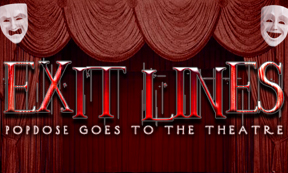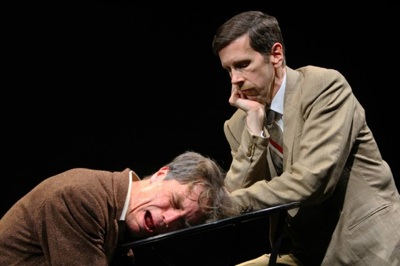 All things must come to an end, and today my neighbor, Michael Shannon, departs Theatre for a New Audience, where’s he spent the last six weeks in a mesmerizing return of Eugene Ionesco’s The Killer to the New York stage. I say “return,” rather than “revival,” as the play, first performed in Paris in 1959, hasn’t been seen here since 1960, so it’s not exactly Cabaret or Les Miz or some chestnut refurbished every few years. It’s a challenging piece of absurdism, running a bit over three hours across three acts, and I applaud TFNA and Shannon, an admirer of playwright Eugene Ionesco, for shaking the tree and finding a place for it here in Brooklyn at the company’s handsome black box space.
All things must come to an end, and today my neighbor, Michael Shannon, departs Theatre for a New Audience, where’s he spent the last six weeks in a mesmerizing return of Eugene Ionesco’s The Killer to the New York stage. I say “return,” rather than “revival,” as the play, first performed in Paris in 1959, hasn’t been seen here since 1960, so it’s not exactly Cabaret or Les Miz or some chestnut refurbished every few years. It’s a challenging piece of absurdism, running a bit over three hours across three acts, and I applaud TFNA and Shannon, an admirer of playwright Eugene Ionesco, for shaking the tree and finding a place for it here in Brooklyn at the company’s handsome black box space.
I also say “neighbor” loosely, as Shannon lives in Red Hook, a neighborhood away from mine. As it happens our kids (yes, General Zod, the Boardwalk Empire flagellant, and “weirdo” Oscar nominee for Revolutionary Road has two children and what I infer to be a pleasant domestic life) have attended the same preschool, and I have seen him out and about, most memorably this past spring when I observed him talking a mile a minute to himself, which seemed a very Michael Shannon thing to be doing, all that normalcy aside. A friend said he was likely running lines, and as there are a lot of them to run in The Killer (its final third is him trying to convince the title character, who does nothing but chuckle malignantly, to stop killing), that made sense.
The Killer doesn’t make conventional “sense,” but it has point of view, and Shannon’s rationale for doing it touched me. Red Hook, which is below sea level, was heavily damaged by Sandy in 2012, while Carroll Gardens and the Columbia Waterfront District, where I live, were not. Why are some communities spared while others are shattered? How does one resist, gather hope, move on in the wake of evil as indifferent as a flash flood? These are questions that Shannon says he asked himself as the play, under the assured direction of Darko Tresnjak (a Tony winner for A Gentleman’s Guide to Love & Murder), came together, and I saw the parallels immediately.
 Shannon’s Berenger, a character who recurs in different guises in Ionesco’s plays (including Exit the King, the only other one I’ve seen staged), is drawn toward the “radiant city,” a lovely, climate-controlled community within his own, humdrum one, perfect save for the serial killer who is drowning residents at a rate of three victims per day. In the first act, Berenger is walked through the radiant city by a bureaucrat, played with quietly delightful detachment by Robert Stanton; in the second, he ponders what to do with an acquaintance, who we, but not Berenger, quickly deduce to be the killer. Paul Sparks, an actor Shannon’s equal, is memorably grotesque in the part, a little Peter Lorre, and a little Uncle Fester, as he slips away from Berenger until their final meeting, which occurs in the face of government apathy. (Putting that face on, and also playing Berenger’s rules-obsessed landlady, is the peerless Kristine Nielsen in a production that does not lack for deft star turns.)
Shannon’s Berenger, a character who recurs in different guises in Ionesco’s plays (including Exit the King, the only other one I’ve seen staged), is drawn toward the “radiant city,” a lovely, climate-controlled community within his own, humdrum one, perfect save for the serial killer who is drowning residents at a rate of three victims per day. In the first act, Berenger is walked through the radiant city by a bureaucrat, played with quietly delightful detachment by Robert Stanton; in the second, he ponders what to do with an acquaintance, who we, but not Berenger, quickly deduce to be the killer. Paul Sparks, an actor Shannon’s equal, is memorably grotesque in the part, a little Peter Lorre, and a little Uncle Fester, as he slips away from Berenger until their final meeting, which occurs in the face of government apathy. (Putting that face on, and also playing Berenger’s rules-obsessed landlady, is the peerless Kristine Nielsen in a production that does not lack for deft star turns.)
Aided by stunning lighting (Matthew Richards) and sound design (Jane Shaw), never more so than when these elements fall away and their absence catches us offguard, The Killer runs deep and dark. Berenger, who’s a little addled (immediately deciding that a secretary he meets, who we see is soon earmarked for death, must be his future wife), nonetheless rallies to present his nemesis with every scientific, religious, and moral argument he can muster against mass homicide, only to have each fall on deaf ears. Don’t we all feel this way when some outrage or another occurs, one we know, as our hearts sink, will happen again and again? There is great humor in the play (the bureaucrats pull rotary phones out of their pockets, an Ionesco gag that became real, and now doubles back on us) and great sadness, and Shannon reveals all of it. He’s an actor of ever-increasing stature, particularly adroit on stage, and a good neighbor, too, for bringing The Killer to us.





Comments